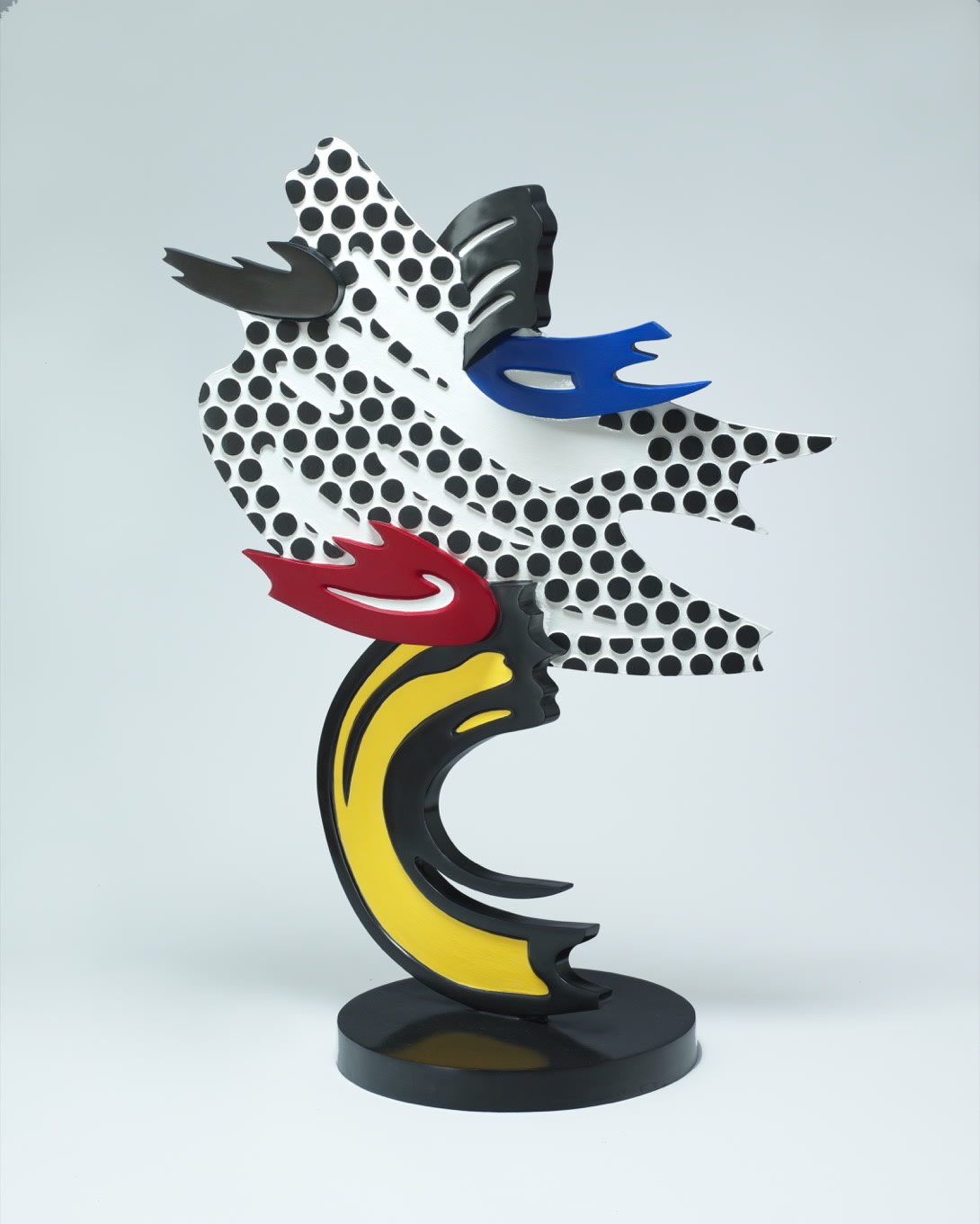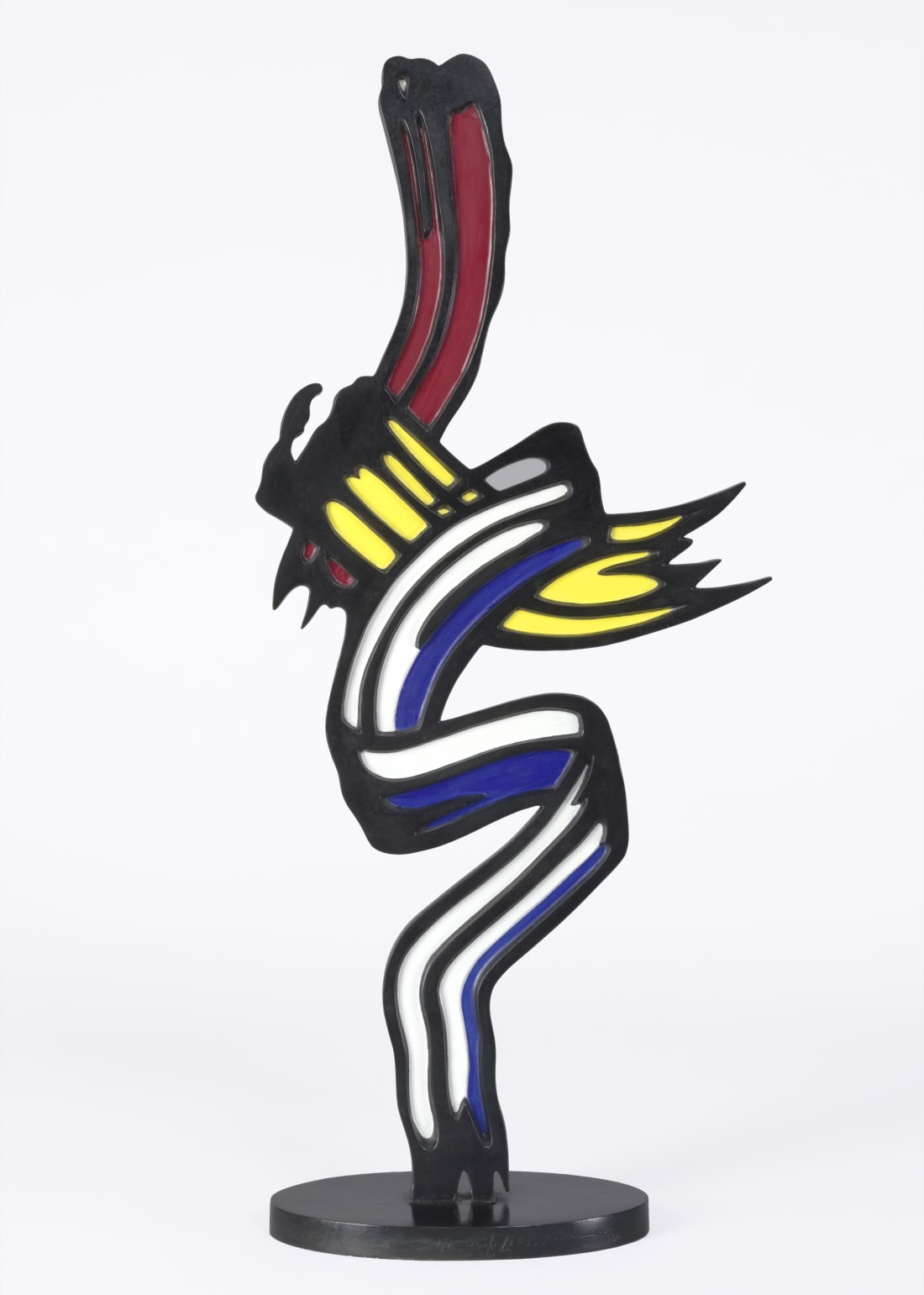

Roy Lichtenstein
Overview
'I am nominally copying, but I am really restating the copied thing in other terms. In doing that, the original acquires a totally different texture. It isn't thick or thin brushstrokes, it's dots and flat colours and unyielding lines.'
Roy Lichtenstein first came to prominence in the early 1960s through large-scale paintings that drew upon the visual repertory of popular culture, in particular comic strips and advertisements. The artist painted by hand, and later using a perforated screen, to mimic the Benday dots used in commercial printing to convey colour gradation and texture, blurring the distinctions between 'high' and 'low' culture in both form and content. He also ventured beyond comic-book subjects, looking back at his art-historical predecessors in paintings that reference Cézanne, Mondrian and Picasso, as well as creating still-lifes and landscapes.
By the late 1960s, Lichtenstein's work had become more abstract, exploring the nature and expressive possibilities of the brushstroke itself. This fundamental component of painting came to the fore as a subject in its own right across both paintings and sculptures. Over the following decades, he further probed questions of formalism and abstraction in his Mirrors series (1969–79), evoking the effects of light and shadow on glass, and the Entablatures (1970–76), which investigated similar phenomena using Beaux-Arts architectural forms. Lichtenstein also created pioneering painted bronze sculptures that subverted the medium's conventional volume and mass, functioning instead as flat lines in space. In the 1970s, he expanded his palette beyond red, blue, yellow, black, white and green, as well as combining invented and found images. Having created his first public mural in 1963, he intensified these efforts in the 1980s and 1990s, painting murals and installing monumental public sculptures in cities across the US, as well as in Europe, Israel, Japan and Puerto Rico.
Roy Lichtenstein first came to prominence in the early 1960s through large-scale paintings that drew upon the visual repertory of popular culture, in particular comic strips and advertisements. The artist painted by hand, and later using a perforated screen, to mimic the Ben Day dots used in commercial printing to convey colour gradation and texture, blurring the distinctions between 'high' and 'low' culture in both form and content. He also ventured beyond comic-book subjects, looking back at his art-historical predecessors in paintings that reference Cézanne, Mondrian and Picasso, as well as creating still-lifes and landscapes.
By the late 1960s, Lichtenstein's work had become more abstract, exploring the nature and expressive possibilities of the brushstroke itself. This fundamental component of painting came to the fore as a subject in its own right across both paintings and sculptures. Over the following decades, he further probed questions of formalism and abstraction in his Mirrors series (1969–79), evoking the effects of light and shadow on glass, and the Entablatures (1970–76), which investigated similar phenomena using Beaux-Arts architectural forms. Lichtenstein also created pioneering painted bronze sculptures that subverted the medium's conventional volume and mass, functioning instead as flat lines in space. In the 1970s, he expanded his palette beyond red, blue, yellow, black, white and green, as well as combining invented and found images. Having created his first public mural in 1963, he intensified these efforts in the 1980s and 1990s, painting murals and installing monumental public sculptures in cities across the US, as well as in Europe, Israel, Japan and Puerto Rico.
Lichtenstein's first solo show was in 1951 at Carlebach Gallery in New York, but it was his debut at Leo Castelli Gallery a decade later that brought him wider recognition in the art world. In 1963, his works were displayed alongside those of Jim Dine, Jasper Johns, Robert Rauschenberg, James Rosenquist and Andy Warhol in the seminal Six Painters and the Object exhibition at the Solomon R. Guggenheim Museum, New York. In 1966, Lichtenstein was among the four artists representing the USA at the Venice Biennale, followed by his first European retrospective at the Stedelijk Museum, Amsterdam. His work has been exhibited in major retrospectives at the Guggenheim Museum (1969 and 1993); the first drawings retrospective by a living artist at The Museum of Modern Art, New York, in 1987, which toured to museums across Europe; and a 2012–13 retrospective organised by the Art Institute of Chicago and Tate Modern, London. His work has been included in seven group exhibitions at the gallery since 1992, followed by a solo exhibition in Salzburg focusing on his works from the 1980s, Roy Lichtenstein: The Loaded Brush (2019).
In accordance with the wishes of the artist and his family, the Roy Lichtenstein Foundation was established in 1998 to facilitate access to his work and that of his contemporaries, and to establish a catalogue raisonné of his works, which is an ongoing project.
Videos

Artworks
Catalogues







































































































































































































